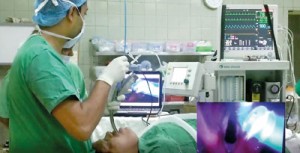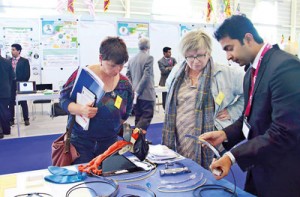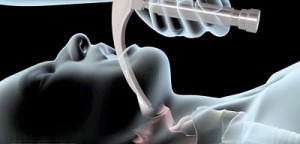News
Lankan doctor’s life-saving intubation invention wins gold
View(s):Foreign countries show interest, but Dr. Herath puts patients before patent
By Kumudini Hettiarachchi
It is not an easy task — and as he assisted many an anaesthetist to ‘intubate’ numerous people, lying on the operating table before an operation or in emergencies, he wondered why it could not be made less challenging.
As they wielded the laryngoscope, a metallic gadget with a handle and a blade, to carry out endotracheal intubation, the Peradeniya Teaching Hospital’s Senior Registrar in Anaesthesia, Dr. Anupa Herath, allowed his inventive mind to dwell on it.

Dr. Anupa Herath performing intubation with his invention – theVideo-Laryngoscope with Extended Functions. Pix by Anurada Bandara
Going beyond the call of duty which is to assist in intubation and keep the vitals of the patient under general anaesthesia at the required levels, Dr. Herath has now come up with a ‘Video-Laryngoscope with Extended Functions’ which can be handled easily, to international and local commendation.
Inserting the laryngoscope down the throat of a patient is the “trickiest” skill in anaesthesia, for intubation is an invasive procedure, says Dr. Herath, acknowledging with humility, that his version of the laryngoscope won gold recently.
Not only did Dr. Herath win the gold medal for his version of the laryngoscope on March 28 at the International Exhibition of Inventions in Geneva, he also received Special Congratulations from the jury.
So impressed was the jury that it requested this 35-year-old doctor-cum-inventor from Sri Lanka to seek a European patent for this medical marvel, with investment interest forthcoming from countries such as Israel, Romania and Switzerland.
“My idea is not to commercialise my product but let the Sri Lankan Government take it forward,” says Dr. Herath simply, for not for him the pursuit of wealth and glory but the wellbeing of people he has sworn to help when he took the Hippocratic Oath. Earlier he had also won the silver medal at the National Inventions Exhibition (Sahasak Nimavum) 2016 for medicine in Sri Lanka, for this invention.
This is not a first for him — back in 2014 he was awarded the gold medal for the Best Invention under the ‘Health and Nutrition Category’ also securing a Special Award for Electronics at the National Inventions Exhibition in Sri Lanka held by the Inventors’ Commission for his ‘Low-cost peripheral nerve-stimulator needle with extended functions’.
Then too when he represented the country at the International Exhibition of Inventions in Geneva, he was awarded a gold medal, while being the recipient of a special congratulatory message from the jury. (Dr. Herath’s achievement was featured in a May 24, 2015 Sunday Times Plus section article headlined ‘A little jab that goes a long way to ease the pain’.)
The Video-Laryngoscope with Extended Functions he has produced this time has made intubation easier.
Usually, in laryngoscopy, a tube is inserted through the mouth of the patient down into the trachea (windpipe or large airway from the mouth to the lungs), before surgery when the patient is put under general anaesthesia or in an emergency procedure when people are unconscious or cannot breathe on their own, without assistance.
The trachea which carries air to the lungs and is usually about four inches long and one inch wide, starts under the voice-box or larynx, extends behind the breastbone or sternum, divides into two smaller tubes called bronchi which then link up respectively with the lungs. The trachea is of tough cartilage, muscle and connective tissue, with the inner lining of smooth tissue.

Dr. Anupa Herath with his invention in Geneva, Switzerland where he won gold
Intubation allows oxygen and anaesthetic gases to be sent in and carbon dioxide to be taken out.
Some of the challenges in conventional laryngoscopy would be if there is reduced mouth-opening, impaired movement of the neck and swelling of the upper-airway. When using the conventional laryngoscope, the larynx has to be lifted and the mouth needs to be opened at least to the size of three fingers.
“It becomes a bit of a struggle,” says Dr. Herath, explaining that if the patient has facial abnormalities, malignancies (cancers), burns, congenital defects, is pregnant or obese there could be difficulty in inserting it.
While this necessitates external manipulation as well as angulation of the tube, various special devices such as stylets have been introduced to manage such difficult cases. But the cost is prohibitive, it is understood.
When using the conventional video laryngoscope, meanwhile, the video allows only the throat and the vocal cords to be seen, with the Anaesthetist literally having to grope in the dark thereafter, it is learnt.
“Delayed or failed intubation would result in fatal complications of anaesthesia in emergency situations,” points out Dr. Herath, explaining that when adequate respiration does not occur, the patient would turn hypoxic due to lack of oxygen, which can cause brain damage, cardiac arrest and death. During tube-placement, the patient’s teeth could get damaged as also the soft tissue at the back of the throat and the vocal cords.
| Video-Larungoscope: How it works The ‘Video-Laryngoscope with Extended Functions’ consists of a metallic blade, a corrugated handle, a camera port, an introducer channel and an oxygenation port.
 How Dr. Anupa Herath’s Video-Laryngoscope with Extended Functions works
Explaining how it works, Dr. Herath says the laryngoscope is advanced deep into the mouth cavity of the anaesthetised patient and the bougie is passed through the vocal cords, with the endotracheal tube being advanced along the bougie. As the tube advances, the bougie gets detached from the scope and the distal end and allows the tube to enter into the trachea. This takes place with real-time video-imaging. The uniform-thickness of this laryngoscope needs only smaller mouth-opening — 2cm or a width of two fingers — and will prevent the patient’s teeth from getting damaged. “I did the calculations and designed the laryngoscope taking into consideration the upper-airway anatomy and its curvature so as to prevent much pressure being caused to laryngeal tissue,” he says. The main advantage is that the haemodynamic response and the soft tissue injuries are minimal as it applies minimal pressure on the laryngeal tissue. “It’s a railroad tube and the laryngoscopy can be carried out without groping about blindly,” says Dr. Herath expressing his appreciation for the support he has received from the Sri Lanka Inventors’ Commission; the College of Anaesthesiologists and Intensivists of Sri Lanka; the National Hospital’s Consultant Anaesthetist Dr. Marie Fernando; Kandy Teaching Hospital’s Consultant Anaesthetist Dr. Saman Karunathilaka; Peradeniya University’s Professor in Anaesthesiology and Critical Care, Prof. Vasanthi Pinto and Professor in Anaesthesiology, Prof. Lal de Silva attached to the Peradeniya Teaching Hospital; and a former President of the College of Anaesthesiologists, Prof. Lakshman Karalliedde. | |

